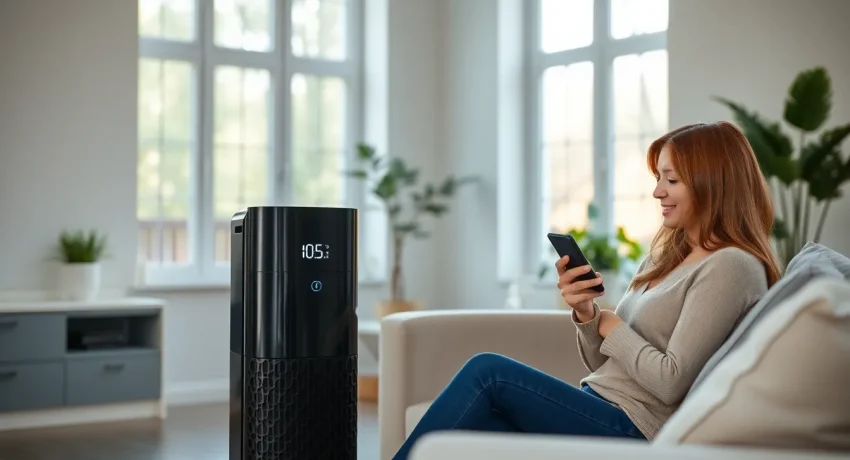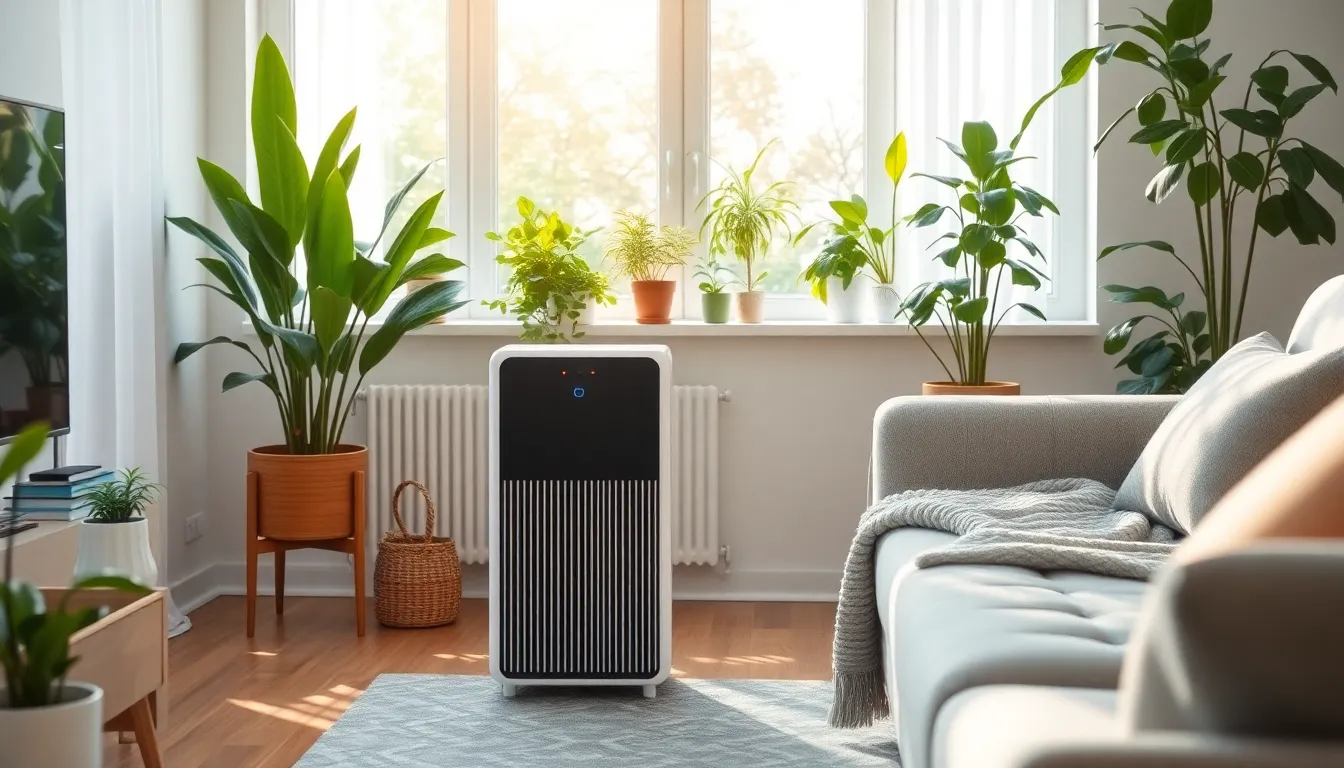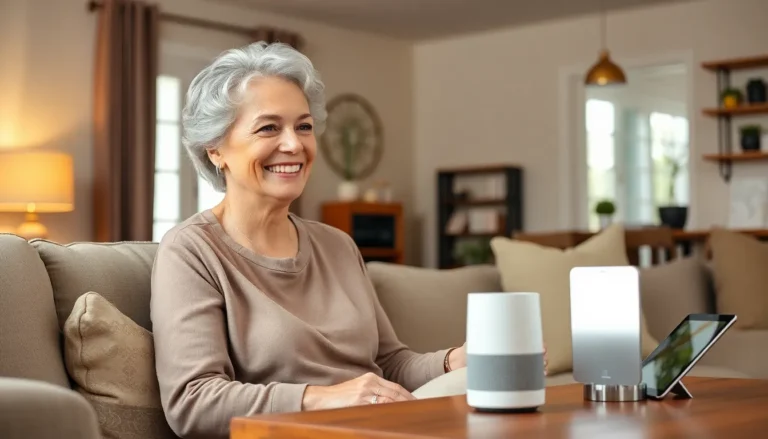Table of Contents
ToggleIn a world where dust bunnies seem to multiply faster than rabbits and allergens throw a never-ending party, smart air purifiers swoop in like superhero sidekicks. These nifty gadgets don’t just filter out the bad stuff; they also keep you in the loop with real-time air quality updates, making them the perfect blend of tech and tranquility. Who knew breathing could be so high-tech?
Imagine kicking back on your couch while your air purifier works tirelessly to combat the invisible foes lurking in your home. It’s like having a personal assistant dedicated to keeping your air fresh and your sinuses happy. With features like app connectivity and voice control, these smart purifiers make managing your indoor air quality a breeze—literally! So, let’s dive into why investing in one might just be the best decision you make for your home (and your lungs).
Overview of Smart Air Purifiers
Smart air purifiers play a crucial role in maintaining a clean indoor environment. These devices combine advanced filtration technology with intelligent features to enhance air quality effectively.
What Is a Smart Air Purifier?
A smart air purifier is an advanced appliance that filters indoor air, removing pollutants like dust, pollen, and smoke. Equipped with sensors, it monitors air quality continuously, adjusting its operation based on real-time data. Connectivity features, such as Wi-Fi or Bluetooth, allow for remote control via apps or voice commands. This integration makes it easier to manage air quality without manual adjustments.
Key Features to Look For
When choosing a smart air purifier, prioritize effective filtration systems, including HEPA filters that capture at least 99.97% of airborne particles. Look for real-time air quality monitoring, enabling users to track pollutant levels. Features like scheduling, energy efficiency, and low noise levels enhance overall convenience. Voice control and compatibility with smart home systems, such as Amazon Alexa or Google Assistant, facilitate seamless integration.
Benefits of Using a Smart Air Purifier
Smart air purifiers offer numerous advantages that significantly impact indoor environments. These devices enhance air quality while providing convenience and efficiency.
Improved Air Quality
Smart air purifiers effectively filter allergens, dust, and pollutants. HEPA filters capture particles as small as 0.3 microns, ensuring cleaner air. Real-time monitoring allows users to see air quality updates instantly, promoting informed decisions. Many models include features like automatic operation adjustments based on detected pollutants. Reduced allergy symptoms can contribute to overall well-being, making these devices essential for sensitive individuals. Smart purifiers often use activated carbon to eliminate odors, adding to the benefits of fresher indoor air. Their comprehensive filtration systems help create a healthier living space, ideal for families and individuals alike.
Energy Efficiency
Energy efficiency stands out among the many features of smart air purifiers. These devices often employ eco-friendly settings, optimizing power consumption without sacrificing performance. Smart sensors can adjust operation based on real-time air quality, leading to lower energy usage during clean conditions. Many models also offer scheduling options, allowing users to run the unit only when needed. Investing in ENERGY STAR certified models guarantees maximum efficiency, saving money on utility bills over time. Additionally, quieter operation compared to traditional models enhances comfort at home. Efficient energy use leads to a smaller carbon footprint, benefiting both the environment and users’ pockets.
Popular Smart Air Purifier Models
Several popular smart air purifiers stand out in the market. Recognized for their advanced features and efficiency, these models provide exceptional air quality management.
Model Comparison
To help users choose, a comparison of leading models facilitates informed decisions. The Dyson Purifier TP01 combines sleek design with powerful HEPA filtration, capturing 99.97% of allergens. The Honeywell HPA250B offers an impressive coverage area of 450 square feet, emphasizing its efficiency for larger spaces. The Levoit Core 400S features multiple fan speeds and integrates seamlessly with smart home systems, making it user-friendly. Each model offers unique strengths, allowing individuals to select the purifier that meets their specific needs.
User Reviews and Ratings
User feedback highlights important aspects of smart air purifiers. Positive reviews often mention the significant reduction in allergens and noticeable improvements in air quality. Ratings above four stars are common for models like the Coway AP-1512HH, praised for its quiet operation and effective filtration. Customers appreciate features such as real-time air quality monitoring and remote control through mobile apps. Many point out that these devices require minimal maintenance, which enhances the overall user experience.
Smart Technologies in Air Purifiers
Smart air purifiers encompass various advanced technologies that enhance indoor air quality. They offer users convenience and real-time monitoring capabilities.
Connectivity Options
Smart air purifiers typically feature Wi-Fi or Bluetooth connectivity, allowing users to control them remotely via mobile apps. These applications provide functionalities such as adjusting fan speed and scheduling operations, making air management seamless. Notifications about air quality levels and filter replacements keep users informed. Some models even support voice commands, enabling hands-free operation through virtual assistants. This connectivity enables users to integrate air purification seamlessly into their daily routines.
Smart Home Integration
Smart air purifiers integrate effortlessly into existing smart home ecosystems. Compatibility with platforms like Google Assistant and Amazon Alexa allows for easy voice control and automation. Users can synchronize purifiers with other smart devices, creating an interconnected environment that prioritizes air quality. Scheduling settings can align with daily activities, optimizing energy use while ensuring clean air is available when needed. This integration helps maintain a healthy indoor atmosphere, promoting overall well-being through advanced smart technology.
Maintenance and Care for Smart Air Purifiers
Regular maintenance ensures optimal performance and longevity of smart air purifiers. Attention to cleaning and filter replacement plays a critical role in their efficiency.
Filter Replacement
Filter replacement operates as an essential maintenance task for smart air purifiers. HEPA filters typically require replacement every 6 to 12 months, depending on usage and air quality. Activated carbon filters often need replacing every 3 to 6 months to maintain odor removal efficiency. Users can monitor filter life through app notifications or indicator lights on the device. Following the manufacturer’s recommendations guarantees the air purifier functions effectively. Keeping track of filter replacement schedules helps maintain a healthy indoor environment and prevents reduced airflow.
Cleaning Procedures
Cleaning procedures help maintain air purifier performance and hygiene. Dust and debris can accumulate on the exterior and intake grilles, impacting airflow. Users should wipe the outer surfaces with a damp cloth regularly. Cleaning the pre-filters is necessary, as they can trap larger particles and extend the life of HEPA filters. Checking and cleaning these components every few weeks enhances overall efficiency. Users should also avoid using harsh chemicals or abrasive materials during cleaning to prevent damage. Regular maintenance ultimately ensures that smart air purifiers continue delivering clean air effectively.
Conclusion
Smart air purifiers represent a significant advancement in maintaining indoor air quality. Their ability to filter allergens and pollutants while providing real-time updates makes them invaluable for health-conscious individuals. With features like app connectivity and voice control, these devices seamlessly integrate into modern lifestyles.
Investing in a smart air purifier not only enhances air quality but also promotes energy efficiency and convenience. The quiet operation and minimal maintenance requirements further add to their appeal, making them a smart choice for any home. By prioritizing effective filtration and smart technology, users can enjoy a cleaner and healthier living environment.





